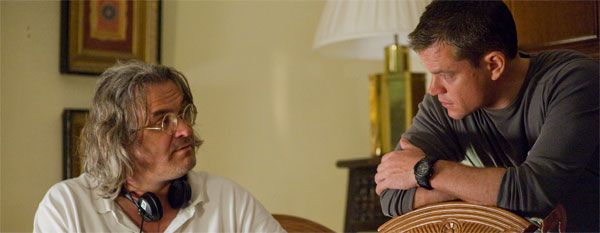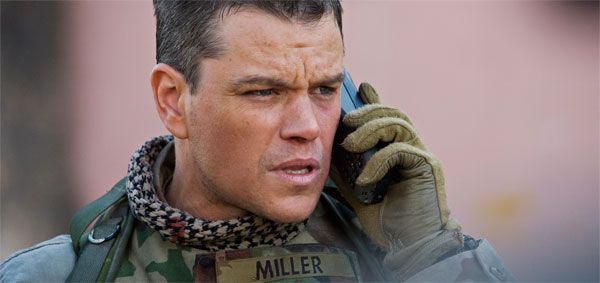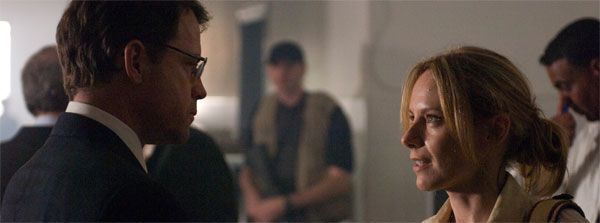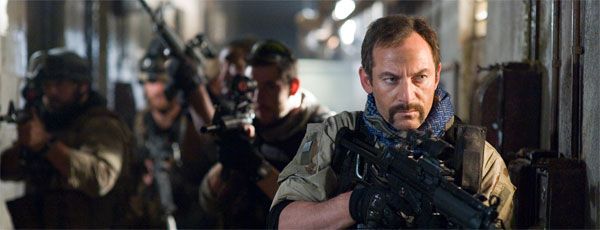After collaborating on the highly successful Bourne sequels, director Paul Greengrass and star Matt Damon’s third film together had everyone excited. Add in that Greengrass’ most recent non-Bourne movie was the great United 93 and fans were eagerly awaiting Green Zone. After an unorthodox shoot (Damon had to take a break in the middle to film The Informant) the film finally got stuck with an unfortunate March release date. Add in the fact that moviegoers were in the midst of a love affair with another Iraq War movie, The Hurt Locker, which won the Oscar for Best Picture just five days before Green Zone’s release and it would seem that the film was doomed to disappoint. The final film is a solid, yet imperfect thriller, despite Greengrass and Damon’s best efforts. Keep reading for more on the film and its DVD.
Green Zone revolves around Damon’s character, Chief Warrant Officer Roy Miller, and his efforts to discover why his team has never found a WMD site despite possessing supposedly accurate reports on each site. Miller learns that CIA analyst Martin Brown (Brendan Gleeson) also notes that something fishy is going on and the two team up to investigate a mysterious source named “Magellan” who gave the government the WMD intel in the first place. Desperately covering up this information is Clark Poundstone (Greg Kinnear) in the Pentagon. Somewhere in all of this is Amy Ryan’s character, a reporter named Lawrie Dayne, who depends on Poundstone and his connection to Magellan for her stories.
Once Miller sets his sights on finding Iraqi General Al-Rawi and learning more about his relationship with Poundstone, Greengrass successfully keeps the film moving and energized. But the real problem here is that the film assumes that the viewer is angry about the Iraq war and will blindly back Miller. While it’s impossible to root for the conniving Poundstone, the script never gives us a moment when Miller really earns our support. We know immediately that Miller is the good guy, but that doesn’t mean we care about him. Damon’s performance is the center of the film and he does a good job of getting the audience’s support, despite being given little to work with.
The film carefully balances to make sure it never gets too political, but it still manages to take plenty of jabs at the government’s handling of Iraq. It’s clear from the beginning that the Pentagon is the villain and the film’s ultimate message seems to be the reminder that the government lied to us. The film also shows us President Bush’s regretful “MISSION ACCOMPLISHED” speech and many Iraqis’ reactions to the U.S.’s presence. In fact, one of the most important characters in the film is an Iraqi civilian who becomes Miller’s translator. Nicknamed Freddie, the translator follows the Americans’ every order but seeks to remind them of the absurdity of Americans running a country where they don’t even speak the language.
The film, which is inspired by a non-fiction book by Rajiv Chandrasekaran called Imperial Life in the Emerald City, seems destined for commercial failure given the timing of its release. Released just five days after The Hurt Locker’s big Oscar night, most casual moviegoers interested in seeing an Iraq War film were bound to see the proven winner. Additionally, while The Hurt Locker is a generic Iraq film, in that it could have happened in any of the past 6 or 7 years and it’s not grounded in any true story, Green Zone is based around our frustrating to revisit entrance of Iraq and the cover-ups that followed. The film was not released immediately after these events when it would still be relevant or decades later when the time period would be considered “history”. Instead the film came out an awkward 6 or 7 years after the events, at a time when people don’t care to view a cinematic reproduction of the events. The film would have been much better suited if it were released closer to the actual events or many years in the future.
Ultimately it is not that Green Zone is a bad film at all, there’s just nothing extraordinary about it. When we heard that Greengrass was tackling an Iraq War film, we just had higher hopes. The end result is a solid thriller built around a controversial topic that does the best it can with its limited script.
The film is presented in 2.40:1 widescreen with Dolby Digital 5.1 sound. Special features include deleted scenes, two featurettes and a commentary track. The deleted scenes can be played with an optional commentary from Damon and Greengrass. This is an interesting feature as you can hear why Greengrass and Damon liked or disliked each particular scene, where they would have fit in the movie, and why they were cut from the film. The first featurette, “Matt Damon: Ready For Action”, shows Damon’s relationships with the veterans-turned-actors in the film and follows Damon throughout the shoot. Mixed in are interviews with these veterans and other crewmembers talking about Damon. The second featurette, “Inside The Green Zone” is basically a making of piece. Finally, the commentary track features Damon and Greengrass talking the viewer through the film.




